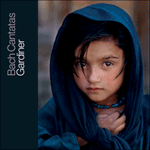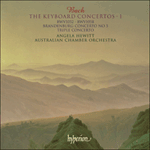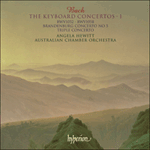
Welcome to Hyperion Records, an independent British classical label devoted to presenting high-quality recordings of music of all styles and from all periods from the twelfth century to the twenty-first.
Hyperion offers both CDs, and downloads in a number of formats. The site is also available in several languages.
Please use the dropdown buttons to set your preferred options, or use the checkbox to accept the defaults.

| Malcolm Proud (harpsichord), Maya Homburger (violin), Rachel Beckett (flute), The English Baroque Soloists, Sir John Eliot Gardiner (conductor)» More |
The second movement is a transcription of the middle movement of the Trio Sonata in D minor, BWV527 for organ. Originally in F major, it is set here in C major. It is almost in the style galant of his son, C P E Bach, although the chromaticisms give him away, as do the amazing shifts in tonality. The dialogue between the three soloists is continuous, but finally comes to rest on the dominant of A minor (the same type of cadence is used at the end of the slow movement of the F minor Concerto). To the original tempo marking of Adagio Bach adds ma non tanto which should serve as a warning not to take it too slowly.
In the solo harpsichord version, the last movement was a fugal moto perpetuo that simply allowed the soloist to show off. With the addition of the orchestra and other soloists, however, Bach produces a work of amazing impact and religious fervour. The swirling triplets of the keyboard part are introduced, interrupted, and finally concluded by a rousing chorus written in alla breve time and reminiscent of the stile antico (Renaissance polyphony). Throughout, everyone but the keyboard player sticks with subject material from this introduction, which is really a variation of the harmonic outline of the fugal subject. Outbursts of quite ferocious chords from the orchestra seem like a condemnation of the sinners. The climax comes with a cadenza for keyboard written over a long pedal point. The final tutti has two different endings in various editions: either major or minor. We have opted for the feeling of hope and salvation that the major mode implies.
from notes by Angela Hewitt © 2005
Le deuxième mouvement est une transcription du mouvement central de la Sonate en trio en ré mineur, BWV527 pour orgue. Originellement en fa majeur, il est ici mis en musique en ut majeur et est presque dans le style galant du fils de Bach, Carl Philipp Emanuel, même si les chromatismes et les surprenants changements de tonalité trahissent la patte paternelle. Le dialogue ininterrompu entre les trois solistes finit par se poser sur la dominante de la mineur (on retrouve le même type de cadence à la fin du mouvement lent du Concerto en fa mineur). À l’indication de tempo originale, Adagio, Bach ajoute un ma non tanto qu’il faut voir comme une incitation à ne pas le jouer trop lentement.
Le dernier mouvement de la version pour clavecin solo était un moto perpetuo fugué qui permettait simplement au soliste de se faire valoir. Mais l’ajout de l’orchestre et des autres solistes débouche sur une œuvre surprenante d’impact et de ferveur religieuse. Les tourbillonnants triolets de la partie de clavier sont introduits, interrompus et finalement conclus par un chœur vibrant, écrit dans une mesure alla breve et renouvelé du stile antico (polyphonie de la Renaissance). De bout en bout, chacun, hormis le claviériste, colle au matériau thématique à partir de cette introduction, véritable variation du contour harmonique du sujet fugué. Des explosions d’accords absolument féroces fusent de l’orchestre comme pour condamner les pécheurs. L’apogée survient avec une candenza dévolue au clavier, écrite sur une longue pédale. Le tutti final présente deux conclusions différentes selon les éditions: en majeur ou en mineur. Nous avons opté pour le sentiment d’espoir et de salut inhérent au mode majeur.
extrait des notes rédigées par Angela Hewitt © 2005
Français: Hypérion
Der zweite Satz ist eine Bearbeitung des mittleren Satzes der Triosonate in d-Moll BWV527 für Orgel. In der ursprünglichen Fassung stand das Werk in F-Dur, hier steht es in C-Dur. Es ist dies fast der style galant seines Sohnes, C. Ph. E. Bach, doch können die chromatischen Passagen und die einzigartigen Tonartenwechsel nur von Bach Vater stammen. Der Dialog zwischen den drei Solisten ist fortlaufend, kommt jedoch auf der Dominante (a-Moll) zur Ruhe (dieselbe Art von Kadenz erklingt am Ende des langsamen Satzes des f-Moll Konzerts). Zu der ursprünglichen Tempoangabe Adagio fügt Bach hier ein ma non tanto hinzu, was als Warnung davor aufgefasst werden sollte, den Satz zu langsam zu nehmen.
In der Version für Solo-Cembalo ist der letzte Satz ein fugaler moto perpetuo, in dem der Solist seine Virtuosität unter Beweis stellen kann. Zusammen mit einem Orchester und anderen Solisten jedoch erzeugt Bach ein Werk von besonderer Wirkung und religiöser Leidenschaft. Die umherwirbelnden Triolen des Tasteninstruments werden von einem mitreißenden Alla-breve-Chor, der an den Stile antico (Renaissance-Polyphonie) erinnert, eingeleitet, unterbrochen und schließlich beendet. Während des gesamten Satzes bleiben alle – bis auf den Spieler des Tasteninstruments – bei dem Themenmaterial der Einleitung, das eigentlich eine Variation der harmonischen Struktur des Fugenthemas ist. Die heftigen Akkord-Ausbrüche des Orchesters scheinen eine Art Verurteilung der Sünder zu sein. Der Höhepunkt kommt mit einer Kadenz für das Tasteninstrument über einem langen Orgelpunkt. Das letzte Tutti hat in verschiedenen Ausgaben verschiedene Schlüsse: entweder Dur oder Moll. Wir haben uns für das Gefühl von Hoffnung und Erlösung entschieden, das in der Durtonart impliziert wird.
aus dem Begleittext von Angela Hewitt © 2005
Deutsch: Viola Scheffel
 Bach: Cantatas Nos 2, 10, 21, 76 & 135 Bach: Cantatas Nos 2, 10, 21, 76 & 135Featuring internationally acclaimed soloists including James Gilchrist, Lisa Larsson, Daniel Taylor and Stephen Varcoe, Volume 2 in the Bach Cantatas series comes from the Basilique Saint-Denis in Paris and the Zürich Fraumünster Kirche.» More |
 Bach: The Keyboard Concertos, Vol. 1 Bach: The Keyboard Concertos, Vol. 1‘Her [Hewitt's] playing is absolutely captivating: she decorates the solo part with playful, come-hither ornamentation—twirls, flutters, arabesques—an ... ‘Hewitt's Bach is well-known for its expressive restraint, lucid textures and rhythmic grace. These virtues are abundantly present in her thoughtful, ...» More |
 Bach: The Keyboard Concertos, Vol. 1 Bach: The Keyboard Concertos, Vol. 1 |

